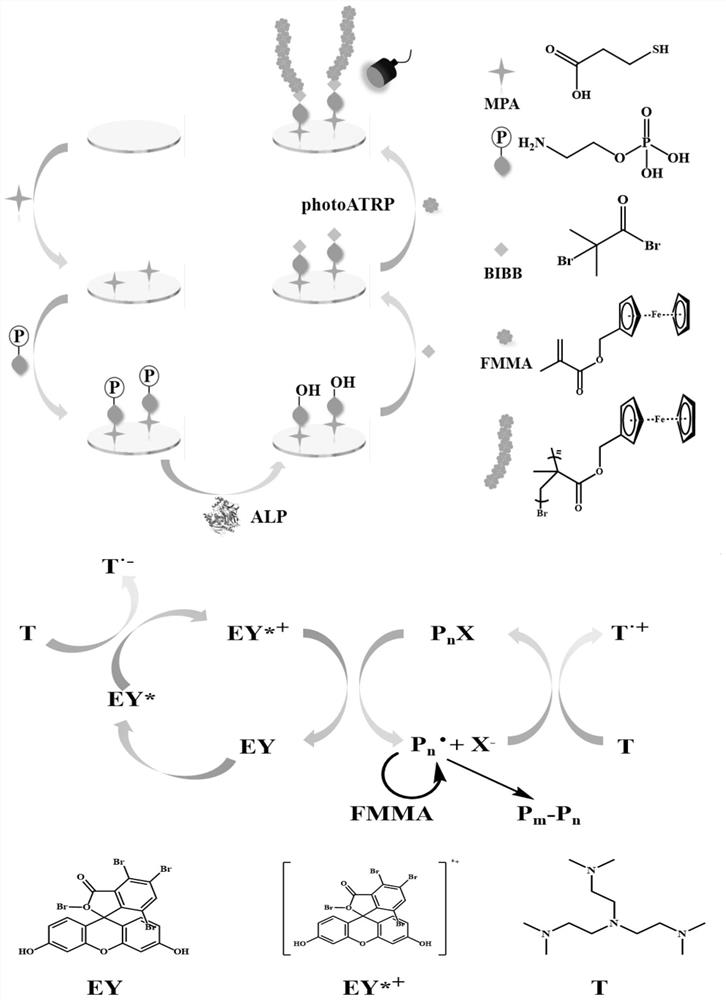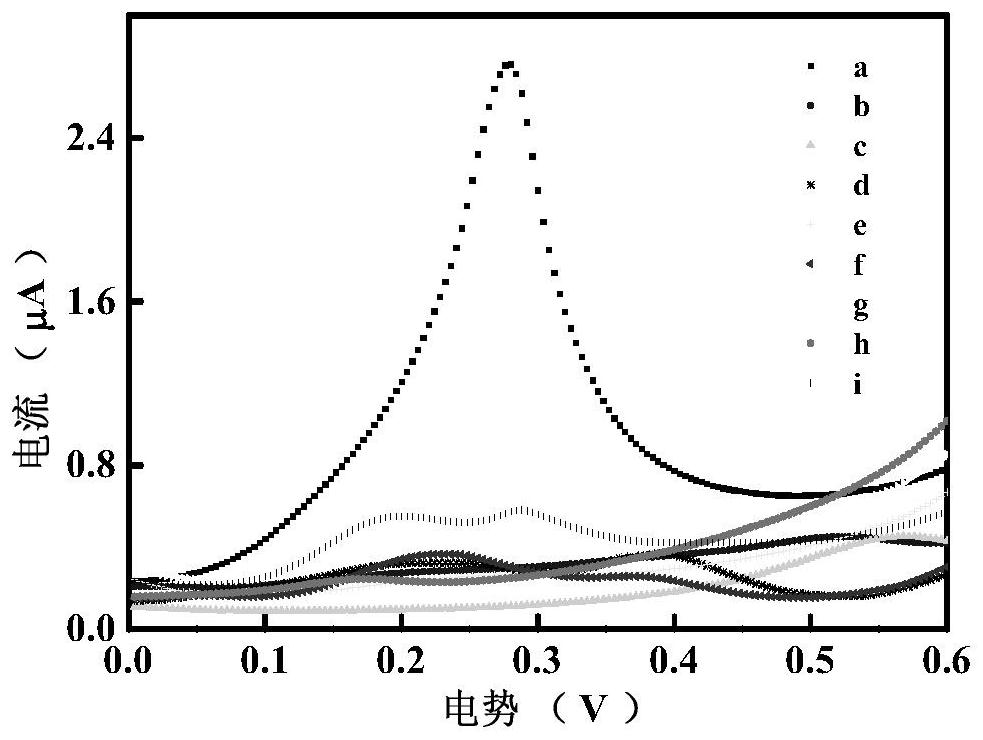ALP activity detection kit based on photo-ATRP signal amplification strategy and use method thereof
An activity detection and signal amplification technology, applied in the field of biological analysis, can solve the problems related to diseases such as osteoblastic bone tumor, osteomalacia, leukemia reaction or lymphoma, ALP inhibition, activity below the normal range, etc. People are satisfied with the effect of selectivity, easy operation and good sensitivity
- Summary
- Abstract
- Description
- Claims
- Application Information
AI Technical Summary
Problems solved by technology
Method used
Image
Examples
Embodiment 1
[0044] Embodiment 1: Kit
[0045] An ALP activity detection kit based on the photo-ATRP signal amplification strategy, including the following raw materials: electrode, 3-mercaptopropionic acid (MPA), 1-(3-dimethylaminopropyl)-3-ethylcarbodiethylene Amine Hydrochloride (EDC), N-Hydroxysuccinimide (NHS), O-Phosphoethanolamine, 2-Bromoisobutyryl Bromide (BIBB), Dimethyl Sulfoxide (DMSO), Eosin Y (EY) , Tris-(N,N-dimethylaminoethyl)amine (Me 6 TREN), ferrocenylmethyl methacrylate (FMMA), LiClO 4 .
[0046] When in use, prepare some raw materials into solutions, wherein the concentration of MPA solution is 10mM, the concentration of EDC in the EDC / NHS mixed solution is 20mM, the concentration of NHS is 5mM, the concentration of O-phosphoethanolamine solution is 10mM, and the concentration of BIBB solution is 10mM. The solution concentration is 5mM, Me 6 The concentration of TREN solution is 10mM, the concentration of FMMA solution is 10mM, LiClO 4 The solution concentration i...
Embodiment 2
[0047] Embodiment 2: ALP activity detection method
[0048] (1) MPA modification
[0049] Soak the pretreated gold electrode in 400μL 10mM MPA solution and incubate at 37℃ for 2h;
[0050] (2) Activation and modification of MPA carboxyl group phosphoethanolamine
[0051] Soak the electrode obtained in step (1) in 400 μL EDC / NHS mixed solution (EDC concentration is 20 mM, NHS concentration is 5 mM), incubate at 37 °C for 0.5 h, then soak the electrode in 400 μL 10 mM O-phosphoethanolamine solution, 37 °C Incubate for 1h;
[0052] (3) ALP dephosphorylation and BIBB modification
[0053] Drop 10 μL of the solution to be detected (including ALP) on the surface of the electrode obtained in step (2), incubate at 37°C for 1 hour, then soak the electrode in 400 μL of 10mM BIBB solution, and incubate at 37°C for 1 hour;
[0054] (4) Light-mediated ATRP reaction
[0055] Soak the electrode obtained in step (3) in the photo-ATRP reaction solution (the reaction solution is to add 3990 ...
Embodiment 3
[0062] Example 3: Feasibility Study
[0063] In this study, a series of blank control experiments were used to study the feasibility of the method of the present invention in detecting alkaline phosphatase (ALP) activity. The SWV curves of various modified electrodes can be found in figure 2 see in. Without MPA (curve b), O-phosphoethanolamine (curve c), ALP (curve d), BIBB (curve e), FMMA (curve f), EY (curve g), Me 6 In the case of TREN (curve h) and no light (curve i), there is almost no electrochemical signal response except for a weak background signal. When the electrode is modified step by step according to the method of the present invention, an obvious oxidation current signal (curve a) can be observed, the peak potential is about 0.28V, and the electroactive molecules of ferrocene in LiClO 4 The potential range in solution is consistent. The generation of oxidation current can be attributed to the electrochemical oxidation of ferrocene electroactive molecules, d...
PUM
 Login to View More
Login to View More Abstract
Description
Claims
Application Information
 Login to View More
Login to View More - R&D
- Intellectual Property
- Life Sciences
- Materials
- Tech Scout
- Unparalleled Data Quality
- Higher Quality Content
- 60% Fewer Hallucinations
Browse by: Latest US Patents, China's latest patents, Technical Efficacy Thesaurus, Application Domain, Technology Topic, Popular Technical Reports.
© 2025 PatSnap. All rights reserved.Legal|Privacy policy|Modern Slavery Act Transparency Statement|Sitemap|About US| Contact US: help@patsnap.com



